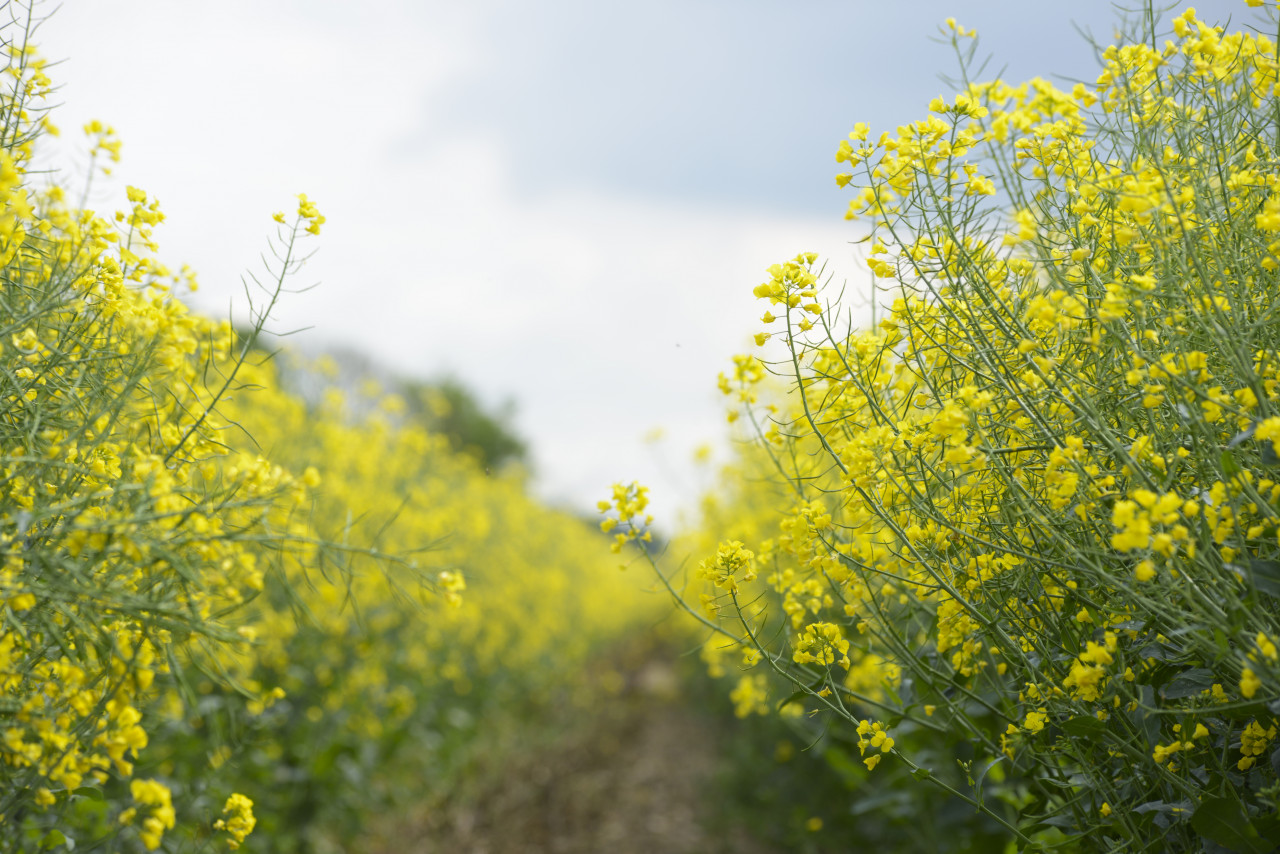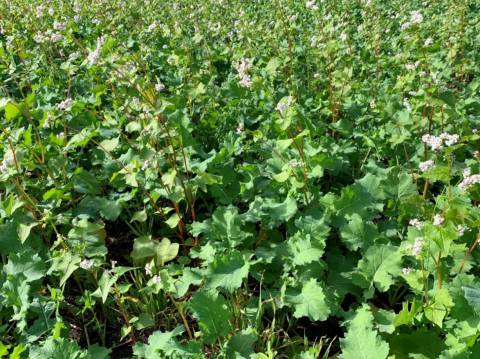Minimise the impact of CSFB by getting oilseed rape off to the best start
Despite recent challenges, oilseed rape (OSR) remains a profitable break crop which can also aid grassweed control in your rotation. Of course, success is dependent on good establishment, which in turn relies on strong attention to detail.
Although recent weather patterns may have presented some difficulties for other combinable crops during the harvest period, there is a silver lining in that the increased soil moisture will aid seedbed preparation and drilling.
Of course, it's well known that OSR is a crop which remains vulnerable to cabbage stem flea beetle (CSFB) so it's important to ensure any risks are reduced. For those of you yet to drill your OSR crops, below are some guidelines to help you plan your crop establishment with the aim of giving the crop the best start and reduce pressure from pests.
Where the damage is done
OSR is most vulnerable to CSFB feeding at emergence, especially when it is unable to outgrow the damage caused by the adult beetles. This feeding can cause the destruction of the growing point of the plants and cause crop failure.
After adult grazing, larval feeding occurs mainly in the petioles (the stalk that attaches the leaf to the stem) and less frequently in the stems. This damage can reduce vigour and although OSR can tolerate a relatively high level of larval damage before yields are impacted, severe larvae infestations can reduce yield and cause plant death.
Resistance to pyrethroid insecticides in the UK CSFB population has also increased and presents additional concerns. Without effective protection in a challenging season, the pest can be more problematic.
How to reduce the risk of CSFB this season
There are factors that can help you reduce CSFB pressure. However, there are no sole solutions or silver bullets, so many of these mitigation measures need to be considered in unison for you to achieve a greater chance of overcoming the pest. To better establish the crop and grow away from any threat, attention to detail is key.
1. Retain moisture
Drill the crop according to soil moisture levels, rather than a prescriptive date. Try to avoid ploughing or other high intensity cultivations that can result in the loss of moisture from the soil. Heavy cultivations can also result in higher levels of CSFB larvae per plant by negatively impacting beneficial insect populations.
A fine, firm, moist seedbed will help to conserve moisture at drilling, which makes establishment more reliable and increases vigour and availability of nutrition. Using a zero-till or direct drill can conserve moisture and the same is also true of rolling (or even double rolling at a different angle to drilling), which can help to close the rows.
2. Stubbles
Leave long stubbles – ideally longer than 20cm.
This benefits moisture management and acts as 'visual confusion', meaning the CSFB can't locate the OSR plant as well as if the plant was alone on the soil surface. Stubble also provides shelter for natural predators of CSFB, such as ground beetles and spiders.
Drill crops early - the target is to have crops reach the two to four true leaves stage by the end of August.
This date is the point of peak adult CSFB migration. Crops at two to four true leaves or beyond are better able to withstand feeding damage. Later drilled crops are not considered optimal as although they tend to suffer less larvae damage as egg laying is reduced in cooler weather, they suffer from increased crop loss from adult grazing.
4. Variety
Consider using a hybrid variety over a conventional variety, for example Turing, LG Wagner, Murray, LG Adeline, DK Expectation and LG Antigua. Hybrid varieties tend to show greater early season vigour above standard conventional varieties. With quick establishment being key to growing away from CSFB, evidence suggests that hybrid varieties are more likely to withstand adult CSFB grazing. If you did want to grow a high yielding conventional variety, I'd recommend Tom.
Find out more about these varieties in the autumn seed catalogue, or watch the 2023 Frontier variety trials videos to find further details about LG Wagner and Tom.
5. Seed rates
Don't be tempted to increase seed rates. Instead, aim for 35-50 seeds/m2 for hybrids and 80-110 seeds/m2 for conventional varieties.
Data from ADAS has shown that increasing seed rates to compensate for plant loss and to dilute the impact of CSFB only serves to increase the total CSFB population per m2. The number of larvae per plant remains the same and so does the proportion of lost plants. Too high seed rates can also lead to taller, weaker plants that are prone to lodging.
6. Seed treatments
It's worthwhile using seed treatments such as Prosper ST and Integral Pro – these are supplied as standard on all Frontier seed.
Integral Pro is a bio-fungicide seed treatment that protects against damping-off. The treatment has been shown to stimulate plant defences and activity to provide a range of benefits, including in root and shoot growth.
Prosper ST contains phosphite and a range of nutrients (N, P, K, Zn, Mg, Mn, Cu, B, Fe, Mo). It's proven to increase the speed of germination, particularly in colder seed beds. Applying phosphite encourages rapid root growth after emergence with gains of up to 30% root mass. This improves access to soil moisture and nutrition.
7. Crop nutrition
Fertiliser, digestate or manure must be applied at drilling to give the crop the best possible start. DAP, Oilseed Start, PhysioStart and OMEX Starter Grades will all efficiently supply nitrogen and phosphate. Biostimulants that contain phosphite, such as Gro Plan P, can also boost root mass growth.
Nitrogen and phosphate are key to quickly establishing OSR, while sulphur will also help improve the use of applied nitrogen. As well as supplying the crop with nutrition, manures, digestates and other organic matter containing fertiliser also help maintain soil moisture (as per point one of this plan). Gro Plan P helps to increase nutrient uptake through a more rapidly developing root system which will be able to support increased shoot growth. 2020 Frontier trials showed an average 0.82t/ha uplift in yield when fertilisers were placed or broadcast.
8. Companion cropping
Cover crops planted alongside can help to visually mask the oilseed rape crop from migrating adult CSFB. However, there are specific cover crop species that can be selected for additional benefits:
- Berseem clover can start to fix N within nine weeks and will break down fast due to its low C:N ratio
- Fenugreek produces a distinct smell that will mask the plant volatiles that the OSR produces that the CSFB uses to identify the plant
- Buckwheat not only mobilises phosphate but will also attract beneficial insects that will predate on the CSFB.
My colleague from Kings Crops, Will Moynan, recommends a mixture of all three drilled at the same time as the rape crop but using a separate hopper to optimise seed rates. Be sure to opt for the more appropriate seed rate for the variety of buckwheat you're using.
Find out more about companion cropping on the Kings website.
An insecticide, in particular EC (emulsifiable concentrate) formulations of lambda-cyhalothrin, have afforded a level of protection when the crops reach threshold: i.e. more than 25% leaf area lost at the cotyledon to two true leaf stage; more than 50% leaf area lost at the three to four true leaf stage; or more than 5 larvae/plant are found.
Despite widespread resistance, pyrethroids are still a critical part of the plan to ensure crop survival. It has enhanced metabolic resistance, so ensure full rates are maintained. Continue to monitor the crop after application to ensure follow up sprays are timely.
10. Adjuvants
The efficacy of an insecticide against adult CSFB and larvae can be improved with the inclusion of an adjuvant such as Intracrop BLA (an extending and sticking agent). Frontier trials have consistently shown an improvement in control while, on the other hand, other additives such as silicon have not shown any benefit.
Summary
Although the recent wet weather has had a negative impact on harvest progress, after a period of extended dry and warm weather it has been a welcome change for our soils. If you're still to drill your OSR, seize the opportunity while seedbed conditions are favourable and follow the steps outlined above to give your crop the best possible chance.
If you'd like help with any aspect of your OSR management, please speak to your local Frontier contact. Alternatively, you can get in touch.
As a subscriber, you’ll receive email alerts each time a new blog is published so you can always stay updated with the latest advice and insights from our experts







Comments